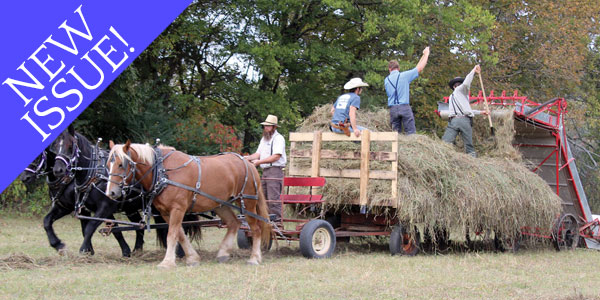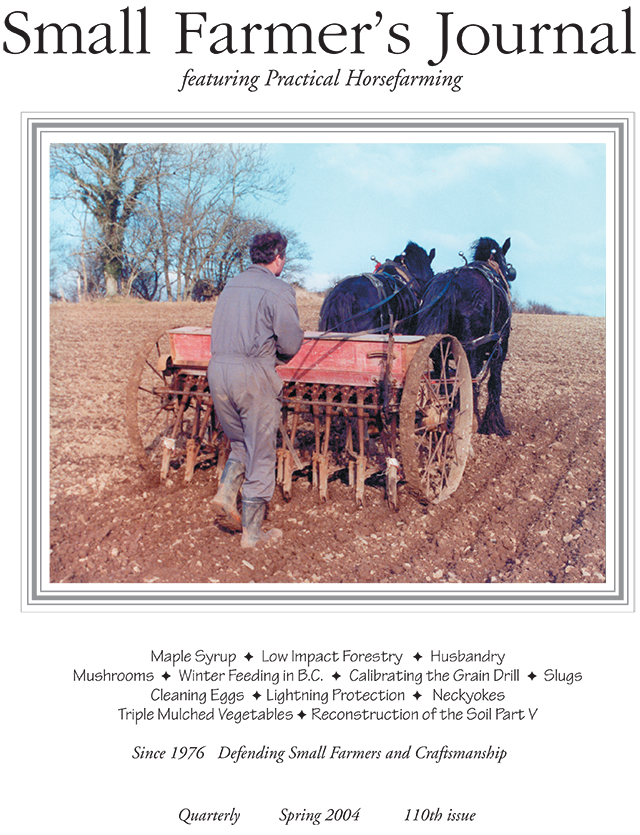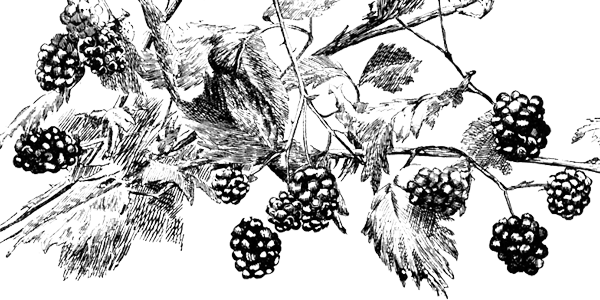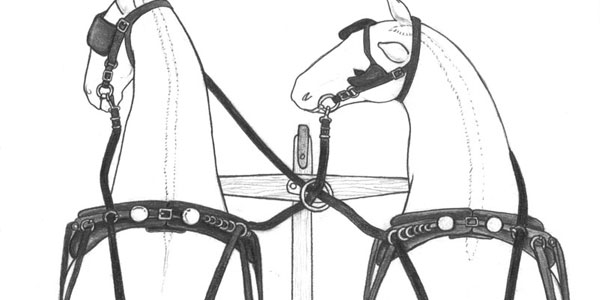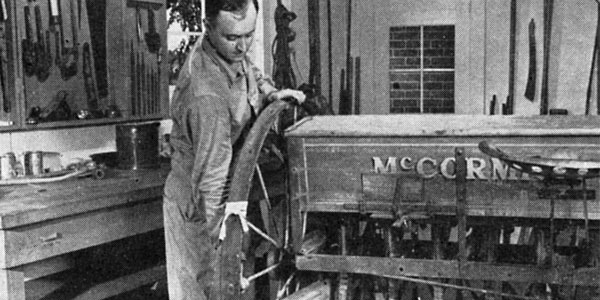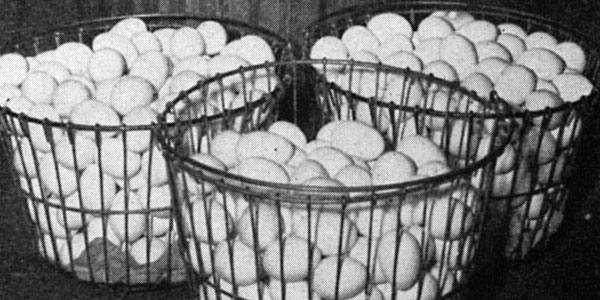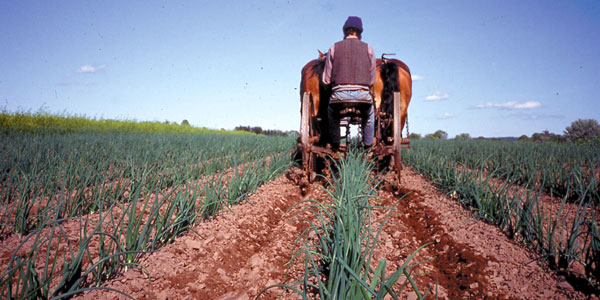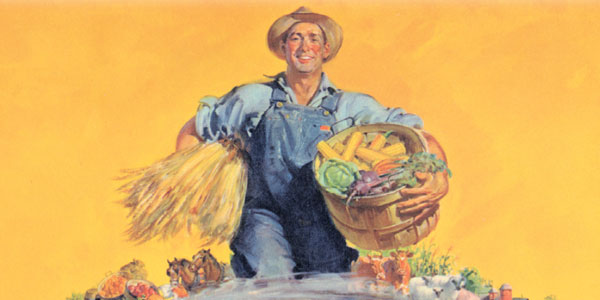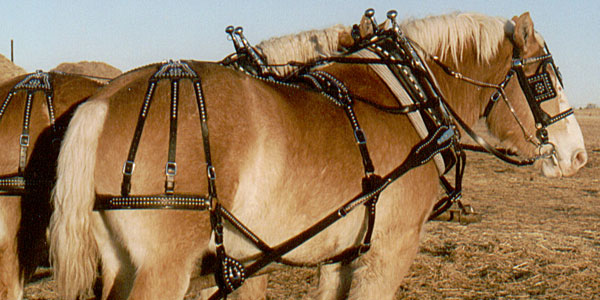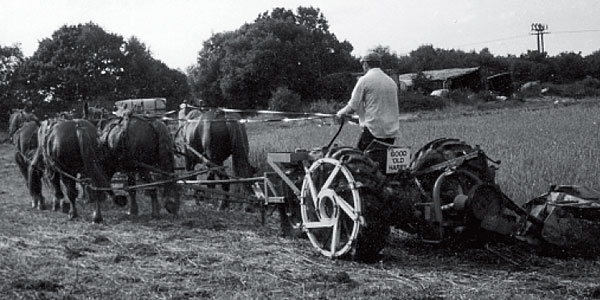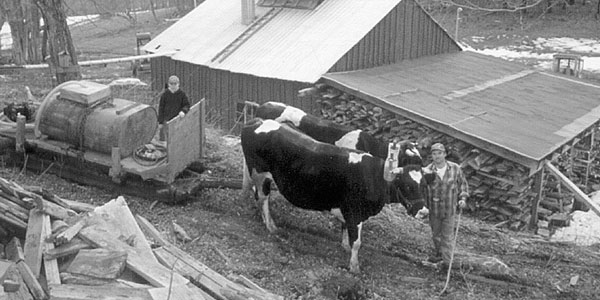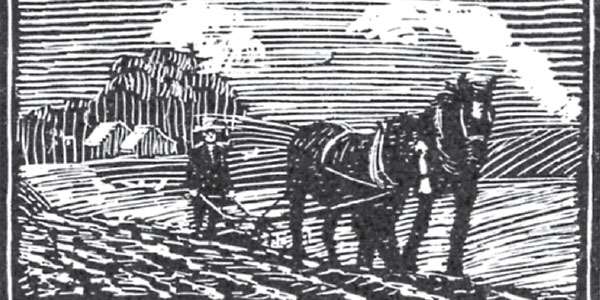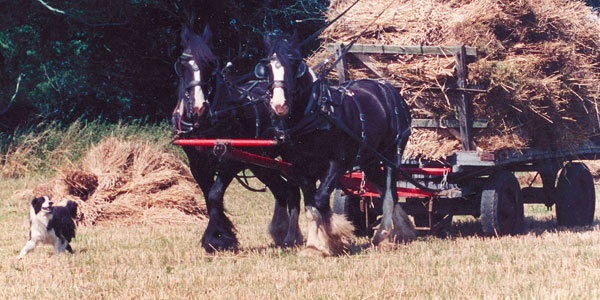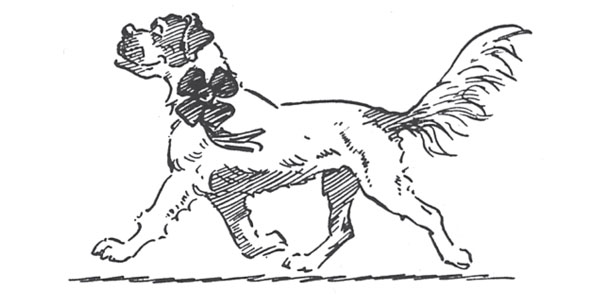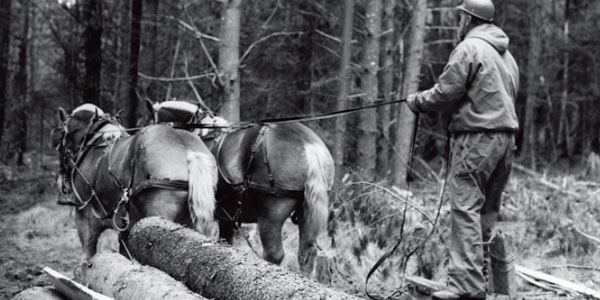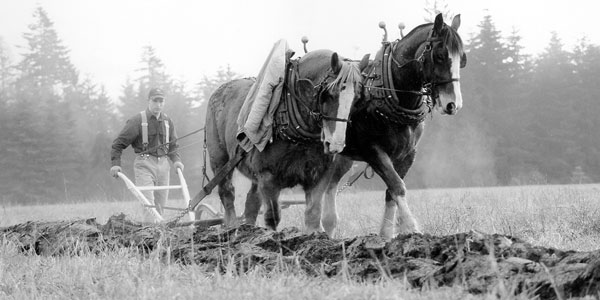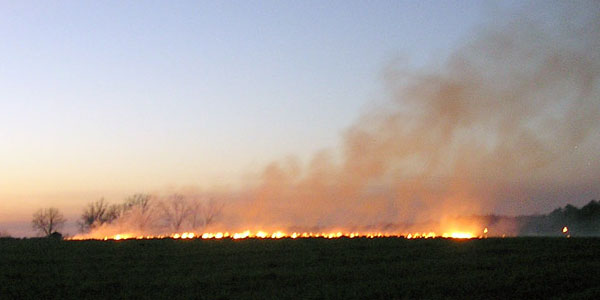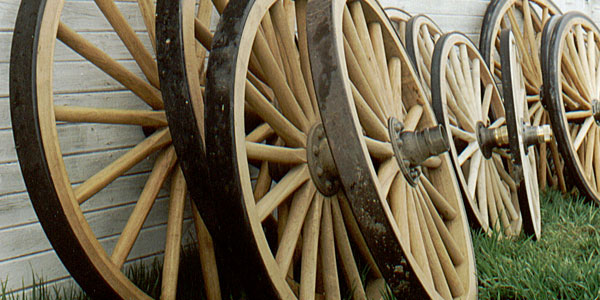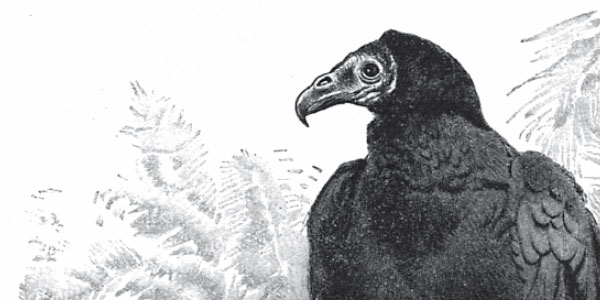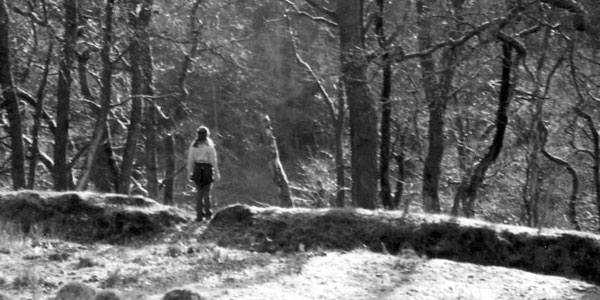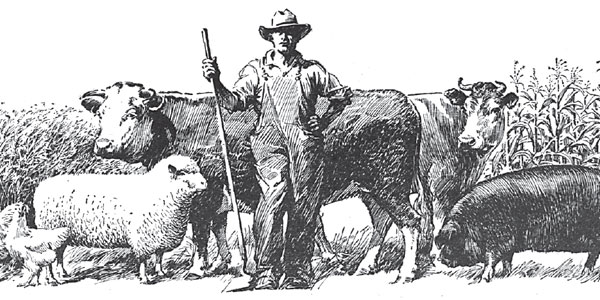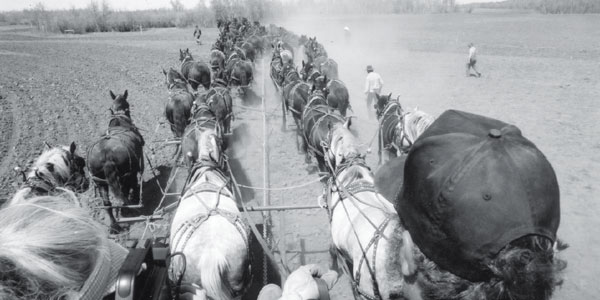Back Issue Vol: 28-2
A Sense of Place
My fingers are purple tonight. We just came back from picking blackberries at the base of the Blue Mountains. It was a great Sunday afternoon and I enjoyed spending it with my family. We have four children between the ages of 5 and 11 who have gotten much better at helping us fill the containers! We do this every August, just before the local county fair. “Our place” is on private property that my uncle rents for summer pasture. I have spent many days in that pasture, chasing cows down the long ridges and out of the brush in the bottoms during fall round up on my saddle horse, Peaches. Mostly I enjoyed these times, but I haven’t gone the past year or so. We all get so busy with our own plans and life fills in the gaps…
Ask A Teamster: Neckyokes
I always chain or otherwise secure slip-on type neckyokes to the tongue so they don’t come off and cause an accident. Neckyokes unexpectedly coming off the tongue have caused countless problems, the likes of which have caused injuries, psychological damage, and even death to horses, and to people as well. Making sure the neckyoke is chained or otherwise secured to the tongue every time you hitch a team is a quick and easy way of eliminating a number of dangerous situations.
Ask a Teamster: Securing the Neckyoke
With most common types of team harness the neckyoke is an essential component of both the steering and hold back systems. In addition to holding the tongue up, neckyokes permit the horses to pull/push the end of the tongue with them as they move right or left, thus steering the vehicle or implement. As part of the hold back system neckyokes function by transferring the – slowing, stopping, backing, and holding back the load – actions of the horses to the tongue, and thus to the vehicle or equipment.
Care and Maintenance of Grain Drills
To begin the calibration of the grain drill, first, partially close each seed gate; then pour some grain into the seed box. Place a canvas under the drill to catch the grain. Be sure that the canvas is under all seed tubes. Lay a board under the drill to protect the canvas when the furrow openers are lowered to operating position.
Clean Eggs Bring More Money
Place the dirty and soiled eggs in a wire basket and lower the basket into water usually containing a detergent sanitizer. The temperature of the water should be maintained between 100 degrees and 130 degrees F. Either the basket is revolved or the water is circulated by compressed air. It takes from 3 to 5 minutes to clean a basket of eggs. When the eggs are clean, remove the basket from the machine and dry as rapidly as possible.
Cultivating Questions: Problem Solving Reduced Tillage Systems
Fearing that the topic of low-till weeds and mulch-loving slugs may not be of general interest, we have made an extra effort to select material on this esoteric subject which demonstrates the problem solving skills necessary for the success of any sustainable farm system. We begin this column by looking at our own problem solving efforts to reduce the population of cool season weeds and high moisture mollusks in the bioextensive market garden, and how we have integrated the resulting cultural practices into the new and improved version of our cover crop/tillage rotation.
Food from Thought
There are many emotional issues surrounding the care and consumption of animals. Because they move, and breathe, and make noise, we can relate to all animals on a most basic level. Whether cat, or deer, chipmunk, draft horse, or milk-cow, we can empathize with their life experience. It is enjoyable to husband farm animals because we can create relationships with them which enhance our own emotional lives. The recognition of the value of these relationships to my life is what compelled me to start raising a diversity of animals on my small farm.
Harnessing Horsepower
As we entered his harness making shop it just exuded an old-world atmosphere. A wood burning stove was heating the area and a subtle aroma of leather made it very pleasant. There was a vast amount and array of horse related items hanging, sitting and standing everywhere, which would take several hours to truly appreciate. It lacked the appearance of anything modern.
Horse-Powered Disc Mower
The great advantage of the rotary disc mower over the reciprocating cutter-bar (sickle bar) mower is that it will keep cutting without blocking up even in bad conditions of laid and tangled crop and in grass which is thick and wet in the bottom. This is why nobody uses anything other than high-speed rotary mowers in the maritime areas of western Europe.
How Do You Know It’s Spring? Maple Syrup!
Once upon a time, I asked my country cousin, Murray Clapp, “Why do you make maple syrup?” He shrugged and said positively, “How would you know it’s spring if you didn’t make maple syrup?” Growing up in Western Massachusetts I always new it was spring when my parents took my sisters and me to the Hilltowns to breathe the maple scented air, watch the sugaring process and taste the unique, sweet syrup.
Husbandry
We were objects of much curiosity when we moved to Cape Breton Island in 1971, and people from miles around came to see what we were up to – and to comment thereon. It appeared that everything we were doing was destined to fail: tomatoes would never ripen here, and as for fancy stuff like peppers and celery! They smiled with pity. Jersey cows? Not a chance. Purebred cattle like that were too delicate to stand Cape Breton winters. But the staggerer was their vehement response to our June haying: That stuff is too green! You’ll never dry that! You’ll have to burn it or throw it over the bank!
Jonathon and Fiona Waterer, British Horsefarmers
Arriving at Higher Biddacott Farm, after driving through the quiet enclosed lanes which wind their way up and down the hills of North Devon, you could be forgiven for thinking that nothing much happens here. But Higher Biddacott is a hive of purposeful activity, with horses coming and going, dogs running about, and people arriving for Bed and Breakfast, or to enjoy the Devon landscape from the back of a horsedrawn wagon.
Lightning Protection for the Farm
Lightning-protection systems for buildings give lightning ready-made lines of low resistance. They do this by providing unbroken bodies of material that have lower resistance than any other in the immediate neighborhood. A protection system routes lightning along a known, controlled course between the air and the moist earth. Well-installed and maintained, a lightning-protection system will route lightning with over 90-percent effectiveness.
Low-Impact Forestry Workshop 2003
The woods are full of horses. A team of Suffolks pulls up to the landing with a load of logs, as a team of Percherons leaves with an empty scoot. Soft bells announce the arrival of a single Belgian, twitching out another log to be bucked into 8-foot lengths and forwarded to the pulp yard. In moments when the chainsaws fall silent, leaving only the sound of bells and hooves and the calls of the teamsters, this could be a forest scene from a hundred years ago.
Mushroom
Decaying vegetable matter, a uniform and rather low temperature, a uniform supply of moisture, – these are the general requisites for Mushroom-growing. The decaying matter is supplied by horse manure. The manure is allowed to heat and is turned several times before it is placed in the bed. The heating itself is probably of no advantage except as it contributes to the decay of the material: heat can be supplied by other means if necessary. The broken and decaying manure is placed a few inches or a foot deep in beds. When the temperature is reduced to 90 degrees or less the spawn is planted. As soon as the bed has cooled sufficiently, it is covered with earth or litter to regulate the temperature and moisture.
Plowing up a Dream
The fourth annual Happ’s Horse Power Days proved to be a weekend of “dreams come true.” The event was expanded this year as we make steps toward building the event into something “bigger and better” for both the competitors and the spectators. We want to provide additional challenges for teamsters and their horses, as well as the opportunity to show what they can accomplish together. We hope to help the public learn about breeds of horses, types of plows and other horse-powered equipment, and bring generations who have drifted so far away from working the land a little closer to understanding what it means to those of us who still follow that way of life.
Reconstruction by Way of the Soil Part 5
This advantage of perennial irrigation is brought about by a permanent high level of the river above a dam or barrage placed in its course. Main canals lead off the heightened water from above the dam and minor canals distribute it. It makes constant use of the artificial high level of the river, and, using the water that flows in the river all the year round, it is obviously not wasteful but conservative. But there is one daring thing about perennial irrigation; it alters the age-long habit of river-made soils in arid countries. What it is made to do is, in fact, to treat these arid soils as if they were soils dependent upon frequent rain, for by means of locks and gates there is a giving of water every ten to twenty days.
The Epiphany
During this period of withdrawal and rehabilitation, weeds grew. The soil lashed out. It got ugly. I reasoned “Why grow something and make nothing when I can grow nothing and make nothing.” Later, someone asked, “What are you growing?” I said, “Dirt,” which, as it turned out came to be true. The question for me became, “How can I make these natural and historically abundant plant nutrients available to the chemically dependent soil once again?” I had to rethink my farming practices.
The Lost Art of a Wheelwright
The process of building a wheel begins with shaping the tennons on the end of a spoke that inserts into the hub. They are fit into the hub as it sits on a wheel table and must be tight and true and at the correct angle. A flange is then put into place to hold them all secure. According to the desired diameter of the wheel, all the spokes are cut to the same length and those ends are pointed, again creating tennons, using a tool that resembles a big pencil sharpener.
The Turkey Vulture: Nature’s Forgotten Environmentalist
I’ve known a couple of Turkey Vultures that waited for me to do chores in the morning at the hay barn. They knew I would be there every day on time. I named them Harry and Carrie. They would perch on the corral rail, across from the hay barn, watching me the whole time. When I was done with chores, they would fly away. I know they grew attached to me, as I grew attached to them!
Visiting the Prices in Wales
When my husband, Steve, showed the request for a pen pal to my daughter, Addie, five years ago, I could never have envisioned the experience that has just taken place. There in the SFJ “letters” section was a request from Owain Price of Wales for a pen pal. He was an 8-year-old, home schooled, farm boy, looking for someone to write to. Addie was experiencing a similar lifestyle across the Atlantic. Both sets of parents looked at it from an academic viewpoint, thinking what a great opportunity to practice writing.
Winter Feeding in British Columbia
November 31st: Beautiful out. Horses are going now. Just for the record, I pulled some logs in for firewood yesterday and that calmed them down a bit. Today, early, I built a stone boat and they pulled it, no problem. So we went up to the shamrock meadow and got an 800 pound bale of hay, which we pulled onto the stone boat with the horses, then came home. Real fun, feeding with the horses. So now we’re in gear to do it. Just about! Not feeding with the sleigh yet.
Withstood
I was somewhat disappointed because I had begun to feel the word differently in its parts and possibilities. “With” and “Stand.” When we have withstood I feel as though we have prevailed, survived, succeeded, rather than to have, in a competitive sense, won against something or someone. I am drawn to the part about being proof against the weight. We Millers have withstood this challenging Winter. We the journal readership have withstood 28 years in partnership with this glorious publication. And we have done it purely together. And that we is a sum which extends backwards and forward, a sum which is more than its parts.
World Record Percheron Draft Horse Hitch
“Heads up!” and a whistle from Head Teamster, Neil Dimmock, and 44 head of Percheron horses lean into their collars to pull in a field a 26 foot cultivator expressly manufactured by Ezee-On Manufacturing of Vegreville, Alberta. This feat set a new World Record for the Largest Hitch of Percheron horses on May 24, 2003. The next day, two more horses were added to the third team from the rear for a total of 46 horses that were hitched to set the World Record for the Largest Agricultural Hitch.




